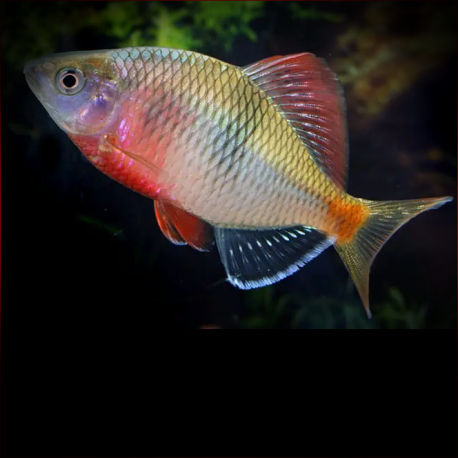Acheilognathus Macropterus
Cypriniformes Print
More info
Datasheet
| Minimum Tank Size | 650 litres / 171.71 US gallons |
| Maximum Size | 27.5cm / 10.83inches |
| Temperature | 14°C / 57.20°F - 22°C / 71.60°F |
General Description
The Acheilognathus Macropterus, commonly known as the Giant Chinese Bitterling, is a species that sporadically appears in the ornamental fish trade and is best suited for experienced aquarists with ample space. Belonging to the Cyprinidae family, this species is characterized by its dorsal and anal fin rays and distinct coloration patterns.
Aquarium Setup
For optimal aquarium setup, a tank resembling a slow-flowing stream or river environment is recommended. Utilizing a substrate of water-worn rocks, sand, and fine gravel can mimic its natural habitat. The tank can be decorated with driftwood, roots, or branches, and hardy plants like Microsorum, Bolbitis, or Anubias species can be added.
Behaviour
Known to be non-aggressive except during breeding periods, the Acheilognathus Macropterus can potentially consume smaller tankmates. It tends to coexist well with similarly-sized and peaceful fish species, such as Zacco, Sarcocheilichthys, Cobitis, or Rhinogobius, sharing similar environmental requirements.
Feeding and Diet
As an omnivorous species, the Giant Chinese Bitterling feeds on insects, their larvae, algae, and other vegetation in the wild. In captivity, it readily accepts various foods, including dried products supplemented with live or frozen fare like bloodworms, Daphnia, and Artemia, promoting optimal coloration and conditioning.
Reproduction & Dimorphism
Reproduction in bitterlings involves a unique spawning symbiosis with bivalve mussels, where females deposit eggs in the mussel's gills, and males fertilize them. Males exhibit more extended fin rays than females, with nuptial males displaying intensified coloration, while nuptial females develop a distinct yellow anal fin and a lengthy ovipositor before spawning.
Habitat and Distribution
The Acheilognathus Macropterus is native to regions including China, the Korean peninsula, northern Vietnam, and southeastern Russia. It has also been introduced in Japan, where it is considered invasive. Typically found in vegetated, slow-moving river sections and standing bodies of water like reservoirs, this species thrives in such habitats.

